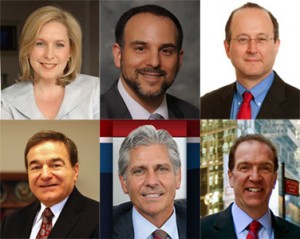For the campaign money race for the junior senator’s seat, incumbentDemocrat Kirsten Gillibrand has more than seven times the dollars of her closest challenger.
Gillibrand has $7.14 million in campaign funds, according to the April 15 report to Federal Election Commission. The totals for two of herRepublican challengers are $1 million for Joseph DioGuardi, a certified public accountant from Long Island; and $386,955 for Bruce Blakeman, a lawyer from Long Island. A Democratic challenger, Jonathan Tasini, a New York City labor activist, has raised $102,006.
As of April 22, the other two challengers — Republican David Malpass, an economist from New York City; and Democrat Scott Noren, an oral surgeon of Ithaca — had not filed any campaign finance reports.
In January 2009, Gillibrand became New York’s junior senator when Gov.David Paterson appointed her to fill seat when then-Sen. Hillary Rodham Clinton became Secretary of State. Gillibrand must now run for election to finish the two years remaining of Clinton’s term. She had been a U.S. Representative from the 20th Congressional District since 2007.
Money is important in a campaign but it does not always determine the outcome of an election, said Robert McClure, a political scientist atSyracuse University. “It seldom is the determining factor in an election,” McClure said. But, he added, “The money she has raised to this point is in large part a function of the strong support she has been able to get from the party and Democratic interests that want to protect this seat.”
A reason that Gillibrand needs a large campaign fund is to scare away opponents with more name recognition, McClure said. “It’s money that’s put out on the table saying here are the stakes,” McClure said. “It pushes away the strongest challengers. That’s where the money is most valuable.”
Among the highlights of Gillibrand’s FEC report:
- Of her total $7.15 million, 83 percent — or $5.9 million — came from named individuals.
- Among her donors giving the maximum of $2,400 are David Caplan, a lawyer at the firm Davis Polk and Wardwell, where Gillibrand was an associate; Mathew Mallow, a lawyer from New York City; and Alan Vickery, a lawyer at the firm Boies, Schiller and Flexner, where Gillibrand was a partner.
- 17 percent — or $1.25 million— came from political action committees or PACs, groups that raise money for candidates or issues.
Of the PACs, 35 gave the maximum amount of $10,000. - Three PACs among those that gave the maximum amount were JP Morgan Chase and Company Federal PAC, which represents that bank; Lockheed Martin Corporation Employees PAC, which represents the defense contractor and its employees; and Morgan Stanley PAC, which represents that investment firm.
As of April 22, Gillibrand had spent 31 percent — or $2.19 million — of her total campaign fund. She had $5.16 million left.
Gillibrand is the only candidate whose report does not include a donation from her own pocket to her campaign.
For Democrat Tasini, the FEC highlights include:
- Of the $102,006 he has raised, none came from PACs.
- Of his 85 individual donors, nine gave the maximum amount of $2,400. Among them are Jules Bernstein, a lawyer from Washington, D.C.; Edward Krugman, a lawyer from New York City; and Betty Sheinbaum, an artist from Los Angeles.
- Tasini has spent 79 percent — or $81,088 — of his total campaign fund. He has $20,916 left.
As of April 22, lists of individual donors and PAC contributions for Bruce Blakeman and Joseph DioGuardi were unavailable. Blakeman has spent 18 percent — or $69,271 — of his total campaign fund. He has $317,683 left. DioGuardi has spent eight percent — or $89,578 — of his total campaign fund. He has $974,223 left.
(Justin Sondel is a graduate student in magazine, newspaper and online journalism.)
-30-



